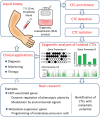Characterization of DNA Methylation in Circulating Tumor Cells
- PMID: 26506390
- PMCID: PMC4690028
- DOI: 10.3390/genes6041053
Characterization of DNA Methylation in Circulating Tumor Cells
Abstract
Epigenetics contributes to molecular mechanisms leading to tumor cell transformation and systemic progression of cancer. However, the dynamics of epigenetic remodeling during metastasis remains unexplored. In this context, circulating tumor cells (CTCs) might enable a direct insight into epigenetic mechanisms relevant for metastasis by providing direct access to systemic cancer. CTCs can be used as prognostic markers in cancer patients and are regarded as potential metastatic precursor cells. However, despite substantial technical progress, the detection and molecular characterization of CTCs remain challenging, in particular the analysis of DNA methylation. As recent studies have started to address the epigenetic state of CTCs, we discuss here the potential of such investigations to elucidate mechanisms of metastasis and to develop tumor biomarkers.
Keywords: CTC; DNA methylation; circulating tumor cells; epigenetics; molecular analyses.
Figures


References
Publication types
LinkOut - more resources
Full Text Sources
Other Literature Sources
Research Materials

